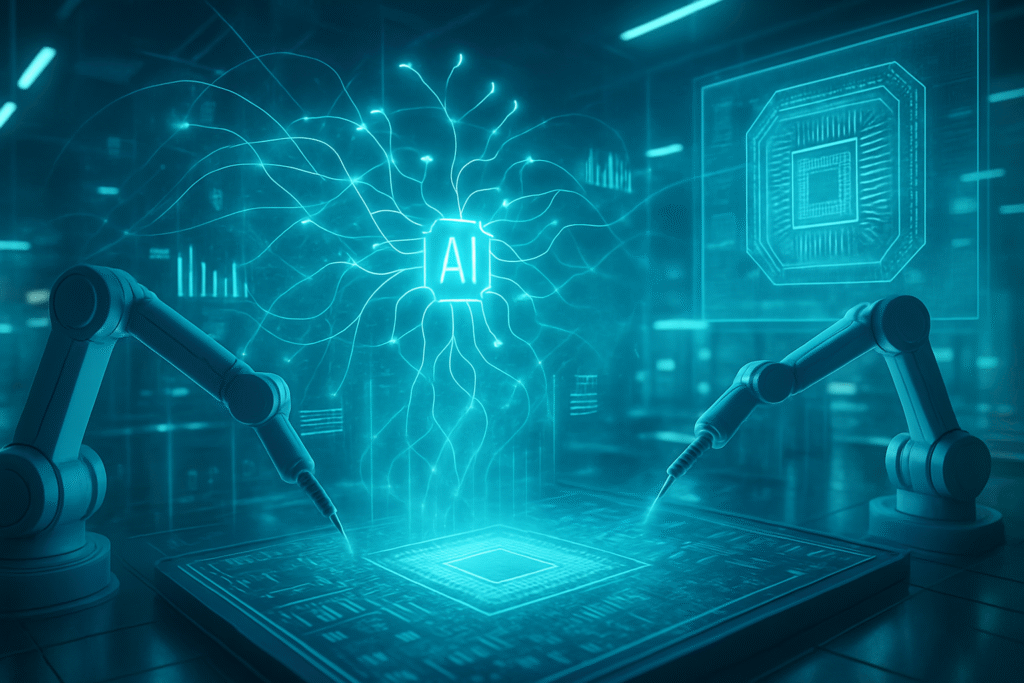
The semiconductor industry, the bedrock of the modern digital economy, is undergoing a profound transformation driven by the integration of artificial intelligence (AI) and machine learning (ML). As of October 2025, these advanced technologies are no longer just supplementary tools but have become foundational pillars, enabling unprecedented levels of efficiency, precision, and speed across the entire chip lifecycle. This paradigm shift is critical for addressing the escalating complexity of chip design and manufacturing, as well as the insatiable global demand for increasingly powerful and specialized semiconductors that fuel everything from cloud computing to edge AI devices.
AI's immediate significance in semiconductor manufacturing lies in its ability to optimize intricate processes, predict potential failures, and accelerate innovation at a scale previously unimaginable. From enhancing yield rates in high-volume fabrication plants to dramatically compressing chip design cycles, AI is proving indispensable. This technological leap promises not only substantial cost reductions and faster time-to-market for new products but also ensures the production of higher quality, more reliable chips, cementing AI's role as the primary catalyst for the industry's evolution.
The Algorithmic Forge: Technical Deep Dive into AI's Manufacturing Revolution
The technical advancements brought by AI into semiconductor manufacturing are multifaceted and deeply impactful. At the forefront are sophisticated AI-powered solutions for yield optimization and process control. Companies like Lam Research (NASDAQ: LRCX) have introduced tools, such as their Fabtex Yield Optimizer, which leverage virtual silicon digital twins. These digital replicas, combined with real-time factory data, allow AI algorithms to analyze billions of data points, identify subtle process variations, and recommend real-time adjustments to parameters like temperature, pressure, and chemical composition. This proactive approach can reduce yield detraction by up to 30%, systematically targeting and mitigating yield-limiting mechanisms that previously required extensive manual analysis and trial-and-error.
Yield Optimizer, which leverage virtual silicon digital twins. These digital replicas, combined with real-time factory data, allow AI algorithms to analyze billions of data points, identify subtle process variations, and recommend real-time adjustments to parameters like temperature, pressure, and chemical composition. This proactive approach can reduce yield detraction by up to 30%, systematically targeting and mitigating yield-limiting mechanisms that previously required extensive manual analysis and trial-and-error.
Beyond process control, advanced defect detection and quality control have seen revolutionary improvements. Traditional human inspection, often prone to error and limited by speed, is being replaced by AI-driven automated optical inspection (AOI) systems. These systems, utilizing deep learning and computer vision, can detect microscopic defects, cracks, and irregularities on wafers and chips with unparalleled speed and accuracy. Crucially, these AI models can identify novel or unknown defects, adapting to new challenges as manufacturing processes evolve or new materials are introduced, ensuring only the highest quality products proceed to market.
Predictive maintenance (PdM) for semiconductor equipment is another area where AI shines. By continuously analyzing vast streams of sensor data and equipment logs, ML algorithms can anticipate equipment failures long before they occur. This allows for scheduled, proactive maintenance, significantly minimizing costly unplanned downtime, reducing overall maintenance expenses by preventing catastrophic breakdowns, and extending the operational lifespan of incredibly expensive and critical manufacturing tools. The benefits include a reported 10-20% increase in equipment uptime and up to a 50% reduction in maintenance planning time. Furthermore, AI-driven Electronic Design Automation (EDA) tools, exemplified by Synopsys (NASDAQ: SNPS) DSO.ai and Cadence (NASDAQ: CDNS) Cerebrus, are transforming chip design. These tools automate complex design tasks like layout generation and optimization, allowing engineers to explore billions of possible transistor arrangements and routing topologies in a fraction of the time. This dramatically compresses design cycles, with some advanced 5nm chip designs seeing optimization times reduced from six months to six weeks, a 75% improvement. Generative AI is also emerging, assisting in the creation of entirely new design architectures and simulations. These advancements represent a significant departure from previous, more manual and iterative design and manufacturing approaches, offering a level of precision, speed, and adaptability that human-centric methods could not achieve.
Shifting Tides: AI's Impact on Tech Giants and Startups
The integration of AI into semiconductor manufacturing is reshaping the competitive landscape, creating new opportunities for some while posing significant challenges for others. Major semiconductor manufacturers and foundries stand to benefit immensely. Companies like Taiwan Semiconductor Manufacturing Company (TSMC) (NYSE: TSM), Intel (NASDAQ: INTC), and Samsung (KRX: 005930) are heavily investing in AI-driven process optimization, defect detection, and predictive maintenance to maintain their lead in producing the most advanced chips. Their ability to leverage AI for higher yields and faster ramp-up times for new process nodes (e.g., 3nm, 2nm) directly translates into a competitive advantage in securing contracts from major fabless design firms.
Equipment manufacturers such as ASML (NASDAQ: ASML), a critical supplier of lithography systems, and Lam Research (NASDAQ: LRCX), specializing in deposition and etch, are integrating AI into their tools to offer more intelligent, self-optimizing machinery. This creates a virtuous cycle where AI-enhanced equipment produces better chips, further driving demand for AI-integrated solutions. EDA software providers like Synopsys (NASDAQ: SNPS) and Cadence (NASDAQ: CDNS) are experiencing a boom, as their AI-powered design tools become indispensable for navigating the complexities of advanced chip architectures, positioning them as critical enablers of next-generation silicon.
The competitive implications for major AI labs and tech giants are also profound. Companies like NVIDIA (NASDAQ: NVDA), which not only designs its own AI-optimized GPUs but also relies heavily on advanced manufacturing, benefit from the overall improvement in semiconductor production efficiency. Their ability to get more powerful, higher-quality chips faster impacts their AI hardware roadmaps and their competitive edge in AI development. Furthermore, startups specializing in AI for industrial automation, computer vision for quality control, and predictive analytics for factory operations are finding fertile ground, offering niche solutions that complement the broader industry shift. This disruption means that companies that fail to adopt AI will increasingly lag in cost-efficiency, quality, and time-to-market, potentially losing market share to more agile, AI-driven competitors.
A New Horizon: Wider Significance in the AI Landscape
The pervasive integration of AI into semiconductor manufacturing is a pivotal development that profoundly impacts the broader AI landscape and global technological trends. Firstly, it directly addresses the escalating demand for compute power, which is the lifeblood of modern AI. By making chip production more efficient and cost-effective, AI in manufacturing enables the creation of more powerful GPUs, TPUs, and specialized AI accelerators at scale. This, in turn, fuels advancements in large language models, complex neural networks, and edge AI applications, creating a self-reinforcing cycle where AI drives better chip production, which in turn drives better AI.
This development also has significant implications for data centers and edge AI deployments. More efficient semiconductor manufacturing means cheaper, more powerful, and more energy-efficient chips for cloud infrastructure, supporting the exponential growth of AI workloads. Simultaneously, it accelerates the proliferation of AI at the edge, enabling real-time decision-making in autonomous vehicles, IoT devices, and smart infrastructure without constant reliance on cloud connectivity. However, this increased reliance on advanced manufacturing also brings potential concerns, particularly regarding supply chain resilience and geopolitical stability. The concentration of advanced chip manufacturing in a few regions means that disruptions, whether from natural disasters or geopolitical tensions, could have cascading effects across the entire global tech industry, impacting everything from smartphone production to national security.
Comparing this to previous AI milestones, the current trend is less about a single breakthrough algorithm and more about the systemic application of AI to optimize a foundational industry. It mirrors the industrial revolution's impact on manufacturing, but with intelligence rather than mechanization as the primary driver. This shift is critical because it underpins all other AI advancements; without the ability to produce ever more sophisticated hardware efficiently, the progress of AI itself would inevitably slow. The ability of AI to enhance its own hardware manufacturing is a meta-development, accelerating the entire field and setting the stage for future, even more transformative, AI applications.
The Road Ahead: Exploring Future Developments and Challenges
Looking ahead, the future of semiconductor manufacturing, heavily influenced by AI, promises even more transformative developments. In the near term, we can expect continued refinement of AI models for hyper-personalized manufacturing processes, where each wafer run or even individual die can have its fabrication parameters dynamically adjusted by AI for optimal performance and yield. The integration of quantum computing (QC) simulations with AI for materials science and device physics is also on the horizon, potentially unlocking new materials and architectures that are currently beyond our computational reach. AI will also play a crucial role in the development and scaling of advanced lithography techniques beyond extreme ultraviolet (EUV), such as high-NA EUV and eventually even more exotic methods, by optimizing the incredibly complex optical and chemical processes involved.
Long-term, the vision includes fully autonomous "lights-out" fabrication plants, where AI agents manage the entire manufacturing process from design optimization to final testing with minimal human intervention. This could lead to a significant reduction in human error and a massive increase in throughput. The rise of 3D stacking and heterogeneous integration will also be heavily reliant on AI for complex design, assembly, and thermal management challenges. Experts predict that AI will be central to the development of neuromorphic computing architectures and other brain-inspired chips, as AI itself will be used to design and optimize these novel computing paradigms.
However, significant challenges remain. The cost of implementing and maintaining advanced AI systems in fabs is substantial, requiring significant investment in data infrastructure, specialized hardware, and skilled personnel. Data privacy and security within highly sensitive manufacturing environments are paramount, especially as more data is collected and shared across AI systems. Furthermore, the "explainability" of AI models—understanding why an AI makes a particular decision or adjustment—is crucial for regulatory compliance and for engineers to trust and troubleshoot these increasingly autonomous systems. What experts predict will happen next is a continued convergence of AI with advanced robotics and automation, leading to a new era of highly flexible, adaptable, and self-optimizing manufacturing ecosystems, pushing the boundaries of Moore's Law and beyond.
A Foundation Reimagined: The Enduring Impact of AI in Silicon
In summary, the integration of AI and machine learning into semiconductor manufacturing represents one of the most significant technological shifts of our time. The key takeaways are clear: AI is driving unprecedented gains in manufacturing efficiency, quality, and speed, fundamentally altering how chips are designed, fabricated, and optimized. From sophisticated yield prediction and defect detection to accelerated design cycles and predictive maintenance, AI is now an indispensable component of the semiconductor ecosystem. This transformation is not merely incremental but marks a foundational reimagining of an industry that underpins virtually all modern technology.
This development's significance in AI history cannot be overstated. It highlights AI's maturity beyond mere software applications, demonstrating its critical role in enhancing the very hardware that powers AI itself. It's a testament to AI's ability to optimize complex physical processes, pushing the boundaries of what's possible in advanced engineering and high-volume production. The long-term impact will be a continuous acceleration of technological progress, enabling more powerful, efficient, and specialized computing devices that will further fuel innovation across every sector, from healthcare to space exploration.
In the coming weeks and months, we should watch for continued announcements from major semiconductor players regarding their AI adoption strategies, new partnerships between AI software firms and manufacturing equipment providers, and further advancements in AI-driven EDA tools. The ongoing race for smaller, more powerful, and more energy-efficient chips will be largely won by those who most effectively harness the power of AI in their manufacturing processes. The future of silicon is intelligent, and AI is forging its path.
This content is intended for informational purposes only and represents analysis of current AI developments.
TokenRing AI delivers enterprise-grade solutions for multi-agent AI workflow orchestration, AI-powered development tools, and seamless remote collaboration platforms.
For more information, visit https://www.tokenring.ai/.





